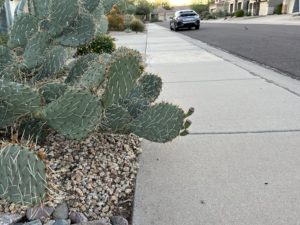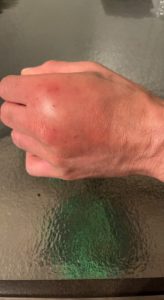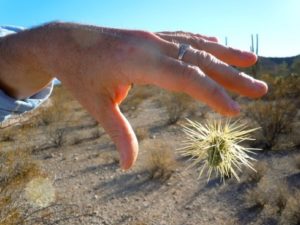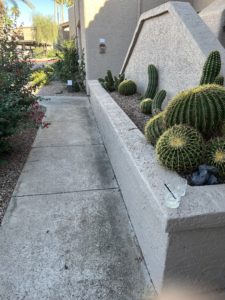Injured By A Cactus? Our Attorneys Can Help You Recover Compensation.
Injured By A Cactus? Our Attorneys Can Help You Recover Compensation.
Anyone who has lived in Arizona for a significant period of time has encountered a cactus. Many residents may even have suffered a cactus injury. Arizona is home to over eighty different species of cacti. Not only are you likely to find cacti in the wild desert landscape, but many private businesses and homeowners transplant them to their property. Though they are nice to admire, cacti are usually covered in spines that are commonly referred to as thorns or barbs. Cacti spines have the potential to cause serious danger to those who encounter them.
Fortunately, most injuries resulting from contact with a cactus are minor and can be treated at home. However, there are some instances when cacti can cause injuries that are much more serious. For example, saguaro cacti can weigh several tons and can grow up to sixty feet tall. Several people are injured in Arizona every year by these large saguaros toppling over onto them.

In addition, some species of cacti have extremely small spines that can be nearly impossible to remove. Worse yet, some of these small spines or thorns can be barbed. When someone comes into contact with a cactus with these small spines they can become embedded in their body or skin causing significant injury. Once these small, barbed, spines are embedded, surgical removal may be required.
Can You Sue If You Were Injured By A Cactus?
Whether or not you can sue for a cactus injury depends on the circumstances of the case. Each case requires an independent fact analysis of several factors. First and foremost, how the injury occurred must be analyzed. Most importantly, the location and presentation of the cactus is critical to establishing liability.
Just because you were injured by a cactus, does not mean you can recover for those injuries. Specifically, you must prove that the cactus created a dangerous condition. The following factors are analyzed in determining if you can recover for a cactus injury:
- Where was the cactus located on the property?
- Was the cactus on public or private property?
- Was the cactus naturally occurring or had it been planted?
- What is the extent of the injuries suffered?
- Was the cactus in a high traffic area?
- Was the cactus trimmed previously or otherwise maintained?
- Did the owner of the property have reason to know that the cactus posed a risk of injury?
- Did the owner of the property have landscapers responsible for maintaining the property?
- What was the person doing that suffered the cactus injury?
- Was the person who suffered the cactus injury in a place where he or she was expected to be?
- Was the person who suffered the cactus injury intoxicated or otherwise impaired?
- Was the injured person lawfully on the property when injured?
- Does the owner of the property have insurance to cover the cactus injury?
- Did the property have adequate lighting if the injury occurred at night?
- Were there previous complaints about the cactus or other unmaintained landscaping?
- Had the same cactus or other unmaintained landscaping previously injured anyone else?
The Lawsuit Our Arizona Attorneys Recently Filed For A Client Injured By A Cactus
Our office recently filed a lawsuit on behalf of a client who was injured by a cactus. After considering the factors listed above, we determined that our client should be compensated. We concluded that the cactus created a dangerous condition at his condominium complex. Specifically, we determined that the cactus dangerously encroached into a sidewalk area where it was likely to injure someone.

Our client was carrying a storage bin and walking on the sidewalk common area of his condominium complex. Our client was injured when his hand made contact with the side of a hedgehog cactus. When this happened, several small spines were lodged deep into his skin.
Our client was rushed to the emergency room where doctors were unable to locate the spines even with x-ray imaging and ultrasounds. The spines caused significant swelling, numbness and discomfort. Ultimately, our client had to undergo surgical removal where the spines were eventually located and removed.
Cactus Injury Cases Should Only Be Brought When The Injuries Are Severe
When deciding to bring a lawsuit for a cactus injury, there are several things to consider. However, the most important, is the extent and severity of your injury. Even though you may bring a lawsuit for any injury where liability exists—cactus injury lawsuits should only be brought if the injuries are significant.
Cactus injury lawsuits should only be brought if the injuries are significant.
This is because claims by those injured from a cactus are defended vigorously by property owners and will likely result in litigation. The property owner will always argue that the injured person was not paying attention and is the one at fault. In the case with our current client, he was forced to undergo an invasive surgery that required him to be under general anesthesia. He also missed significant time from work and continued to experience nerve damage. The details regarding his injury and medical treatment are below.
The Specific Details Of Our Client’s Cactus Injury And Treatment
Our client’s left hand hit a cactus which resulted in several barbs being lodged into his skin. He felt tremendous pain that was sharp and burning. The client went into his home and attempted to remove the cactus barbs that were sticking out from his skin. The client was able to remove one of the barbs but was unable to remove all of them. He then sought out professional medical attention at the emergency room.
At the emergency room, the attending physician attempted to use an adhesive to remove the remaining barbs. However, this was unsuccessful. Our client still felt the barbs even after several attempts to remove them. Unfortunately, because the barbs were so small, even x-ray films could not locate their precise location inside our client’s hand. Due to the complexity of the situation, our client was advised that he would need to seek treatment from a certified plastic surgeon to remove the remaining barbs.

Our client then followed up with a hand surgeon the following day. Our client was advised that surgery may be needed to remove any cactus barbs that were still in his hand. Even if there were no barbs embedded in his hand, surgery was still indicated to examine the damaged tendons and to address other inflammatory responses that required drainage.
Cactus Injuries May Require Surgery
A few days later our client reported back for the needed surgery. He knew that he still had barbs embedded deep into his skin as he could feel them whenever moving his finger. In addition, his hand was still significantly swollen and discolored. The surgery was a major procedure that required our client to undergo general anesthesia.
Several deep incisions were made into our client’s hand and a total of three cactus barbs were removed. Our client’s hand was then irrigated and stitched to prevent any future infections. Our client was discharged and instructed to keep his hand wrapped and to avoid any physical activity for the several weeks as it healed.
Despite the successful surgery, our client still lost feeling in his finger and is unable to move it the way he once could. He went to physical therapy sessions in an effort to regain full movement. Our client was also left with several permanent scars on his hand as a result of the surgery.
Location Of The Cactus and Notice Are The Most Important Factors In A Cactus Injury Case
The most important factors to consider when bringing a cactus injury case are the location of the cactus and the owner’s “notice” that the cactus created a dangerous condition. If you were injured by a cactus, the case will be treated as a standard premises liability case. This means that you will be alleging that the owner of the cactus was somehow negligent by either failing to maintain the cactus or by placing it in a dangerous place.
Therefore, the first step is to determine who owns the property where the cactus is located. If the cactus is wild and was located in a national or municipal park, it will be extremely difficult to win your case. This is because of Arizona’s Recreational Immunity Statute, A.R.S. § 33-1551. The Recreational Immunity Statute bars injured people from suing public and private owners of land for negligence if the land is being used for recreational or educational use. This would typically apply to all private and municipal parks where cacti are present.
However, if the cactus was transplanted on private property and the property is not used for recreation, you will have a much better chance at succeeding. As mentioned earlier, the legal analysis should be treated the same as if you were injured by any other dangerous condition on the property. This means that the characteristics of the cactus are very important to your case.
Some characteristics to consider include the species, placement, and maintenance of the cactus. Certain subspecies of cacti, such as the Cylindropuntia Fulgida (Jumping Cholla) have a higher probability of injuring someone and should not be placed in areas where people are likely to walk. This is because several species of cacti, such as jumping chollas, have stems that can detach from the base of the cacti and have microscopic barbs on their spines which make removal extremely painful. As such, the placement of the cactus is just as important as the type of cactus being planted.

When Does A Cactus Create A Dangerous Condition And When Should The Owner Know
Whether or not a cactus is considered “dangerous” is a question of fact for a jury to determine. For this reason, it is very important to take photographs of the cactus and the surrounding area where the injury occurred. Photographic evidence is useful for both capturing the cactus and showing the overall nature of the property. In addition to the hazard, the scene may show things that suggest the property owner did not reasonably maintain the property in a safe condition.
In the case of our client, the cactus was protruding out of a flower bed and was planted right next to a walkway. This made the cactus even more dangerous as there was an extremely high probability that someone would make contact with it. Likewise, the cactus appeared to have never been trimmed. Had someone maintained the cactus properly, it would have likely not extended out of the planting bed and into the walkway.
Placement Or Planting Of A Cactus In Hight Traffic Areas Can Cause Dangerous Injuries
An argument can be made that a cactus should never be planted in an area close to where people will be. As such, safe landscaping practices dictate that harmless plants be planted near walkways and sidewalks. Cactus, and other plants that can cause injury, should be planted away from these areas.

This should be accounted for in any landscaping plan. If a cactus is planted anywhere near a high traffic area, it has the potential to grow and encroach into that area. A cactus planted next to a walkway, sidewalk or high traffic area must be inspected regularly and maintained so it does not create a safety issue and cause injury.
Scottsdale Injury Lawyers Reach Settlement for Client Injured by Cactus
We were able to resolve our client’s case discussed above for $40,000. This required filing a lawsuit and litigating the case. However, we believed that our client’s injuries were significant enough and that the cactus was unreasonably dangerous.
Most importantly, after we filed the lawsuit, the condominium complex completely removed the dangerous cactus. This means we not only helped our client, but potentially helped other people who may have suffered an injury if the cactus remained and continued to grow. This was especially important to us since the cactus was at the height where a small child’s face and eyes would be. By advancing the case, we were able to make the community a safer place.

Contact An Experienced Scottsdale Injury Attorney to Discuss Your Cactus Injury Case
If you were seriously injured by a cactus or by any dangerous condition on another’s property, then you should contact Scottsdale Injury Lawyers today. Do not discredit your case without talking to a skilled Scottsdale personal injury attorney. An experienced personal injury attorney from Scottsdale Injury Lawyers is available now to discuss your case. A consultation is free and we only earn a fee if we recover for you.
About the author: The content on this page was provided by Scottsdale personal injury attorney and civil rights lawyer Tony Piccuta. Piccuta graduated with honors from Indiana University-Maurer School of Law in Bloomington, Indiana (Previously Ranked Top 35 US News & World Report). Piccuta took and passed the State bars of Arizona, California, Illinois and Nevada (all on the first try). He actively practices throughout Arizona and California. He is a trial attorney that regularly handles serious personal injury cases and civil rights lawsuits. He has obtained six and seven figure verdicts in both state and federal court. In 2022, he set a record $11.75 million dollar settlement for a case he handled against Maricopa County. He has been recognized by Super Lawyers for six years straight. He is a member of the Arizona Association of Justice, Maricopa County Bar Association, Scottsdale Bar Association, American Association for Justice, National Police Accountability Project and Consumer Attorneys of California, among other organizations.
Disclaimer: The information on this web site is for informational purposes only and does not constitute legal advice. The information on this page is attorney advertising. Reading and relying upon the content on this page does not create an attorney-client relationship. If you are seeking legal advice, you should contact our law firm for a free consultation and to discuss your specific case and issues.
References:

